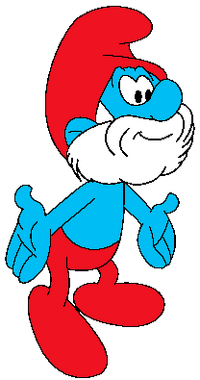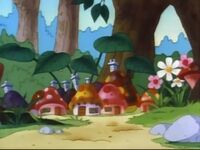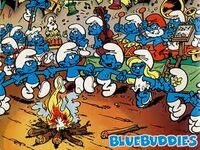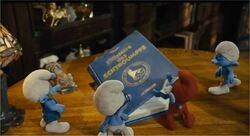- You may also be looking for the cartoon show called Smurfs. For information about the history of the comic book characters themselves, see Smurfs (comics).
The Smurfs are the main character species that appear in the Smurf comic books, the Smurfs cartoon show, and any visual presentation featuring them with the exception of the Johan And Peewit comic book series and "Cartoon All-Stars To The Rescue", where they appear as supporting characters. Their first appearance is in the original comic book story "The Smurfs And The Magic Flute" in 1958.
They are little blue human-like creatures that live in a small mushroom-house village hidden within a forest, the exact location of which is unknown to all but Smurfs and Mother Nature. According to the 2011 Smurfs movie, Smurfs are native to the European country of Belgium and were originally known by their French name Schtroumpfs, as documented in-universe by Peyo.
NOTE: Most of the following information is derived from observations of the Smurfs cartoon show and pertains mostly to the cartoon show universe of stories and characters. Applications to their counterparts in other visual media will be noted here.
Physical Makeup
Physically, a Smurf is usually no more than "three apples tall" (in human measure, probably around 3 inches; the 2011 movie records them as being 7.5 inches) and has a pear-shaped body with an oval-shaped head, springy legs, and limber arms, with a short stubby tail sticking out from his or her buttocks. The springy legs allow a Smurf to jump to high places or across rocks and branches rather easily. According to the Sony Pictures Imageworks animators, the Smurfs in the film can run up to 10 feet per second and have a vertical leap of 4-12 inches.
Smurfs are primarily a single-gender race that are generally born male (though Smurfs do not physically reproduce, they do come into the world by a stork that delivers them to the Smurf Village from an unknown location); very few Smurfs are female, and those that are are most likely magical creations rather than natural-born Smurfs.
- Nanny Smurf may be the only exception as far as female Smurfs are concerned, but since little has been revealed about her origin as a female Smurf, it is uncertain whether she truly is a naturally-born female Smurf.
The male Smurf is mostly bald and relatively hairless. He does not begin to sprout facial hair (a beard and/or moustache) until sometime around his 400s, as mentioned by Papa Smurf in "Symbols Of Wisdom". The "non-canonical" Gutsy Smurf, interestingly, may be the only exception to this rule, as he wears sideburns despite being around the same age range as his fellow Smurfs. Grandpa Smurf, being in his 1000s, is the only known male Smurf at present who also has head hair growing around the back of his head, indicating that additional hair growth may be a sign of advancing age for a male Smurf. Because of the lack of head hair, male Smurfs wear hats on their heads. Besides that, male Smurfs also only wear pants, though a few Smurfs do wear clothing on their torsos; no specific reason is given for this, though it simply may be a matter of function and/or comfort for them. Given that on occasion few Smurfs would wear nothing more than some gloves and a scarf in addition to a hat and pants in cold weather, it would appear that Smurfs are also somewhat physically adaptable to weather changes.
Smurfs tend to age slower than humans and thus live longer than humans. A Smurf reaching his 100 years of age is usually considered an adult, with relative mental maturity of humans somewhere between mid-adolescence and early twenties, though some depictions of young Smurfs have them behaving more like pre-adolescent children. It is rare for a Smurf to live to around 1000 years of age, as Grandpa Smurf has done. In the cartoon show, this is due to the effects of the Long Life Stone, which has kept the Smurfs from accelerated aging and their possible destruction. No similar explanation has been given for their longevity in their other media appearances.

Hefty eating a hot dog in "King Smurf"
Though it is suggested that Smurfs tend to be vegetarians, there are rare occasions where some Smurfs are seen eating meat-based products, such as Hefty with his hot dog in "King Smurf". A few plants that are essential to their diets are sarsaparilla leaves and smurfberries.
Smurfs are considered highly sought after by wizards, since they are part of the ingredient for the formula that turns base metals into gold.
In "The Miracle Smurfer", It's said that their blue skin cures every human illness.
In the 2011 Smurfs movie, Gargamel prepared a formula made from a portion of Smurf essence, mostly from Smurfette's hair, that had various magical properties, including restoring the youth of Odile Jouvenel's mother.
General intelligence
The general intelligence of the Smurf race in whole seems to be based on a level of obliviousness. Examples of that can be found in stories like "The Purple Smurfs", where Handy Smurf carries an infected Smurf over his shoulder, leaving himself wide open for that infected Smurf to bite him and infect him as well. Or when the Smurfs have succeeded to capture an infected smurf and bring him to Papa Smurf's lab, but only Papa Smurf was smart enough to flee the scene when that infected Smurf escapes while all the others just go "He bit me!" and basically let themselves be infected.
Another good example is in the comic book version of the "King Smurf" adventure, where the nameless Smurf who would eventually become King Smurf had figured out that the way to get the others to elect him as their replacement leader until Papa Smurf returns is to make them promises, but he has no intention whatsoever to keep them. The others never even considered that King Smurf would betray their trust, and it's only when they are forced to build his castle that they realize this.

King Smurf made good use of how gullible the other Smurfs were and they resent that.
In that same story it's Brainy Smurf who most clearly shows the obliviousness that seems to be part of the Smurf race. When he sees the pamphlets promoting the future King Smurf, he goes "How nice of them to print pamphlets for me, but they forgot my glasses." He also time after time fails to acknowledge that he's not that popular with the others and is genuinely surprised to find that he received only two votes at the election.
Furthermore in that story, when King Smurf is taking his troops into the woods to look for the rebel camp, he tells them to imitate the hooting of an owl to signal when they found the camp. Failing to understand the seriousness of their assignment, some of them actually start practicing how to make that sound leading to some false alarms. Cumulating into King Smurf being drawn to a real owl that's been hooting and one of his troops going.
"Ah that smurfs it, I figured that was a smurfily good imitation."
Even Papa Smurf, who is regarded as the wisest of his kind, has displayed the same obliviousness, most obviously in "Smurf Versus Smurf" where during the duration of the story he was completely unaware of the unrest in his village, being too engrossed in his lab work. As he finishes his lab work with an astounding success, he is completely caught off guard when he finds that not only has the language problem not solved itself, but that the village has been split in two and the two halves are at war with each other. To his shame he admits to himself that if only he had paid more attention to what was going on, he would stop it before it went as far as it did.
Lastly, the Smurfs ALWAYS fall for Jokey Smurf's joke with the exploding gifts, no matter how many times they received one before.
Society Structure And Culture

Papa Smurf, the leader
The Smurfs are led by a single adult Smurf of advanced years, who happens to be Papa Smurf, who is around 542 years old (546 in the movie). He functions as both a village leader and a father figure, directing them in their daily tasks and serving as a mediator in disputes, using his skills, wisdom, intelligence, and power with benevolence. Each Smurf is given a name that's usually based on a talent, an occupation, or a dominant personality trait exhibited by that Smurf; the name can define that Smurf's particular role in their society, though at times a Smurf may seek to expand his range of talents and abilities or to outgrow certain traits they are named after. (In the Smurf comic books, unnamed Smurfs are simply called Smurf.) Sometimes a foreman would be selected among the young Smurfs to direct the other Smurfs in their tasks, such as Hefty. Why Papa Smurf is the only Smurf that wears red clothing while most of the other Smurfs wear white is unknown, though it may simply suggest leader status. Grandpa Smurf's wearing yellow may also indicate that different generations of Smurfs wear different colors.
The Smurfs' community generally takes the form of a cooperative, sharing and kind environment based on the principle that each Smurf has something he or she is good at, and thus contributes it to Smurf society as he or she can. In return, each Smurf appears to be given their necessities of life, from housing and clothes to food. The Smurfs have no use for money, though at times they may trade something valuable to outsiders in order to get something they need, as Wooly has done in "Wild And Wooly". An attempt to introduce a capitalist monetary system in the comic books' depiction of Smurf society in "The Finance Smurf" has resulted in the Smurfs turning entirely against it. In either media, this is usually interpreted by some readers and/or viewers as the Smurfs promoting communism, though their society is more of a close-knit family than a nation of individuals.

The Smurf Village
The Smurf community at the present time of their adventures consists of a little over 100 Smurfs, which includes Papa Smurf, Smurfette, 98 male Smurfs of around 150 years old, Baby Smurf, three young boy Smurflings of 50 years old who were originally adult Smurfs around the age of 150 years old , Sassette, Grandpa Smurf, Wild, and Nanny. Some additional residents of their village include pets such as Puppy, a 1000-year-old dog that Homnibus the wizard had given to the Smurfs, Smoogle, a pink marsupial-type animal that has been a companion of Nanny, and Feathers, a crane pet of the Smurfs and a mode of transportation,
Smurfs communicate in a language that they call Smurf, which is just basically a variation of a human language where the word "smurf" is used to substitute for a noun, verb, adjective, or adverb. The language is rather intuitive since only Smurfs can understand what each other are really saying in Smurf.

Smurfs dancing in a typical Smurf celebration
Smurfs celebrate birthdays and holidays, including some that are rather indigenous to the Smurf community at large. They also enjoy various recreational activities as well as arts and music, including their local sport of smurfball. Smurfs usually sing the Smurf song whenever they're happy doing something (or just happy).
Smurfs tend to be nature-based in their belief system (though some do hold to the concept of a "heaven" and a "hell", as demonstrated in "Heavenly Smurfs" and in "The Egg And The Smurfs"), and have certain rituals that involve elements in nature. Marriages (between male and female Smurfs) are very rare, if they even happen at all, though it is possible that such do happen.
See the article Smurf customs for a list of customs indigenous to the Smurf people.
History
As far as established history goes, Papa Smurf was born the son of Grandpa Smurf, who left on a 500-year journey to find the purest sources of the four known elements to restore the Long Life Stone. Nanny Smurf had followed after Grandpa Smurf in order to look for more yarn, which left Papa Smurf for the most part alone, though he was taught magic by a wizard named Palladore, who was trapped in stone along with other wizards by a group of druids.
Roughly around 150 years prior to the present time set in the cartoon show, Papa Smurf became the father of about 98 young Smurfs, though it is not known how they were raised with Papa Smurf as their sole parent. They first met Gargamel when he was in his late teens, which inspired his desire for revenge against them when they had foiled his first plot to capture them. Years later, Gargamel created Smurfette to be his weapon to destroy the Smurfs, but when Smurfette expressed her desire to become a real Smurf, Papa Smurf used his magic to change her into a real Smurf, thus foiling Gargamel's plans.
From that time on, other Smurfs have joined the group, and the Smurfs have met other humans which included their constant allies Sir Johan and Peewit. In the animated version of "The Smurfs And The Magic Flute", their first encounter took place when Peewit came across a magic flute that the Smurfs were looking for that fell into the hands of a thief named Matthew McCreep, and together they helped Johan and Peewit stop the thief and his associate Earl Flatbroke from taking over their kingdom. Eventually seventeen Smurfs have been trapped in time due to the misuse of the time crystals, leaving the future of the Smurfs uncertain from that point on.

The Smurfs are about to discover their own legend has been recorded!
In the "non-canonical" 2011 Smurfs movie, their history and legend has been documented by a cartoon artist named Peyo (who in the real world is their creator) and written in a book called L'Histoire des Schtroumpfs which the Smurfs find in Mr. Wong's Mystical Emporium in New York City, which they search through in order to find the spell to make the blue moon appear so they could open the portal back to their own place in time.
Name Translations
The name Smurf is derived from the Dutch translation of their original French name Schtroumpf when their comic book series was first published in Belgium. Since they have become internationally known, the name has also been translated into various other languages, as follows:
- Arabic: سنافر (sanafer) or singular: سنفور (sanfur)
- Basque: pottokiak (singular: pottoki), after the Basque pony race pottoka. Early editions used pitufoak, straight from Spanish.
- Bulgarian: Смърфовете (Smurfovete) - The Smurfs or singular: Смърф (Smurf).
- Catalan: Barrufets (singular: Barrufet), that in Catalan means little wind evil or goblin.
- Croatian: Štrumpfovi (singular: Štrumpf)
- Czech: Šmoulové (singular: Šmoula), name based on their light blue colour.
- Danish: Smølfer(ne) (singular: smølf). Originally published as "Snøvserne" (singular: snøvs)
- Dutch: smurfen (singular: smurf)
- Estonian: smurfid (singular: smurf)
- Finnish: smurffit (singular: smurffi) [the word "strumffit" (singular: strumffi) was used in the 1970s, but smurffit became the de-facto-standard translation during the 1980s]. When they were first published in Finland in the early 70's, they were called Muffet (singular: Muffe). "Smurffit" is also a slang word for public transport ticket inspectors, who wear blue uniforms.
- French: schtroumpfs (singular: schtroumpf)
- German: Schlümpfe (singular: Schlumpf). The original French schtroumpf sounds very similar to the German word Strumpf meaning "sock" or "stocking".
- Greek: Στρουμφάκια (stroumfakia) or singular: Στρουμφ/Στρουμφάκι (stroumf/stroumfaki)
- Hebrew: דרדסים (dardasim) or singular: דרדס (dardas). Dardak is a small child. The somewhat rare Hebrew word "dardas" has a totally unrelated meaning (slipper or overshoe), and therefore should be treated as an invented word when referring to smurfs. It is still used in an insulting manner towards short people.
- Hungarian: törpök (singular: törp), and also: hupikék törpikék (singular: hupikék törpike). Please note that it is a spelling mistake to write these terms in capital letters.
- Icelandic: strumparnir (singular: strumpur)
- Italian: puffi (singular: puffo), the name has been reinvented from scratch because in Italian language the "schtroumpf" (or in Italian spelling 'strumpf') reminds speakers of the slang Italian word "stronzo", literally meaning 'turd' and, by extension, 'asshole'. The fantasy name "puffi" is derived from the word "buffi" (singular: buffo, as in opera buffa) a word meaning at same time "funny" and "strange".
- Japanese: スマーフ (sumaafu - a phonetic approximation)
- Korean: 스머프 (seumeopeu - a phonetic approximation)
- Lithuanian: smurfai (singular: smurfas)
- Macedonian: Штрумфови (Štrumfovi) or singular: Штрумф (Štrumf)
- Mandarin (Chinese): 蓝精灵 (Simplified Chinese) /藍精靈 (Traditional Chinese) (lán jīng líng) - blue fairy spirits/elves/pixies; 藍色小精靈 (lán sè xiǎo jīng líng) - little blue fairy spirits/elves/pixies
- Norwegian: smurfene (singular: smurf)
- Polish: smerfy (singular: smerf; since the 1990s used as a slang word for traffic policemen due to their blue uniforms and white caps)
- Portuguese: In Portugal they're known as estrumpfes (singular: estrumpfe); in early editions they were called Schtroumpfs, as in the original French. Brazil knows them as smurfs, but when first introduced in the storybook format they were called "Strunfs"
- Romanian: Ştrumfi (singular: Ştrumf)
- Serbian: Штрумпфови (Štrumpfovi) or singular: Штрумпф (Štrumpf)
- Slovak: Šmolkovia (singular: Šmolko)
- Slovenian: Smrkci (singular: Smrkec)
- Spanish: Pitufos (singular: Pitufo; female: Pitufita or Pitufina). The name derives either from "Patufet", a slightly similar looking character (short, smurfish cap wearing) of the Catalonian folklore (basically, the Catalan counterpart of British Tom Thumb), or from pituso[6] ("cute child"). The term "Pitufo" was later incorporated in Spanish slang meaning "local policeman" due to their blue uniforms. In 1974, the Smurfs appeared in TBO Magazine under the name "Tebeítos".
- Swedish: Smurfer(na) originally, currently more often called "smurfar(na)" (singular: smurf)
- Turkish: Şirinler (singular: Şirin; feminine – Şirine) the name means cute in Turkish.
- Urdu: اسمرف (ismarf)
- Vietnamese: xì trum
- Welsh: Y Smyrffs (Singular: Smyrff)
Trivia
- Contrary to popular belief, the phrase that is often used to describe the height of most Smurfs ("three apples high," the direct translation of the French idiom "haut comme trois pommes") was never a precise scientific measurement. It means that something is really small, and an English equivalent would be "knee-high to a grasshopper".
- The Smurfs are actually based on a fictional elf race that appeared in a short film, whcih was called "La Cadeau à la fée" ("The gift to the fairy"), made by a company called "La Compagnie Belg D'Actualités", whom Peyo used to work for as a young man.
